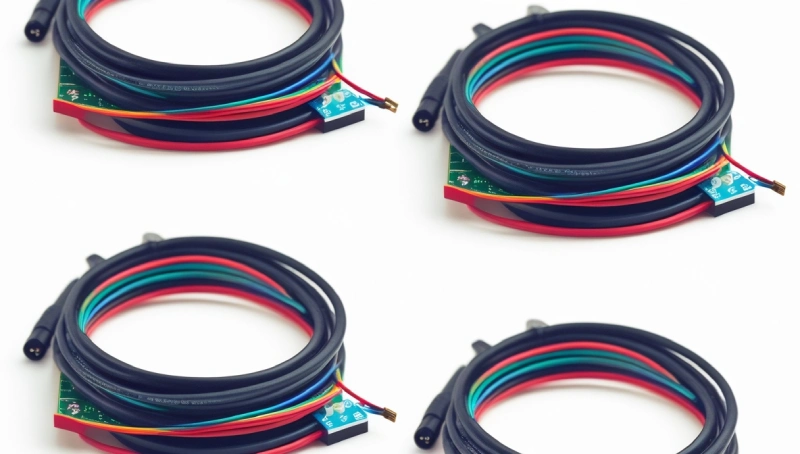Introduction: What Is Stepper Motor Wiring?
If you’re building a 3D printer, CNC machine, or robot, chances are you’ll need to connect a stepper motor wiring setup. But wiring these motors can feel confusing, especially if you’re new to electronics. Don’t worry—we’ll simplify it!
Stepper motor wiring refers to connecting the motor’s wires to a controller (like an Arduino) or driver to control its movement. The right motor wire setup ensures your motor runs smoothly, while mistakes can lead to jittery movements or even damage. In this guide, we’ll cover everything from identifying wires to fixing common issues. Let’s get started!
Understanding Stepper Motor Types
Not all stepper motors are wired the same. Their wires depend on how they’re built:

- 4-Wire Motors (Bipolar):
- Simplest to wire.
- Two separate coils.
- No center taps.
- 5-Wire Motors (Unipolar):
- One center tap per coil.
- Often used in small projects like DVD drives.
- 6-Wire Motors (Bipolar/Unipolar):
- Flexible—use as bipolar or unipolar.
- Extra wires act as center taps.
- 8-Wire Motors (Most Versatile):
- Can be wired in series, parallel, or half-coil.
- Best for high-performance tasks.
How to Identify Motor Wires (No Datasheet? No Problem!)
Got a motor with mystery wires? Here’s how to figure them out:
Step 1: Use a Multimeter
- Set to resistance (Ω) mode.
- Test pairs of wires. If two wires show resistance, they’re part of the same coil.
Step 2: Look for Color Codes
- Common codes: Red/Blue = Coil 1; Green/Black = Coil 2.
- Center taps (5/6/8-wire motors) are often white or yellow.
Step 3: Label the Wires
- Use tape to mark coils (e.g., “Coil A” and “Coil B”).
Stepper Motor Wiring Configurations
How you connect the wires affects power, speed, and torque:
1. Unipolar Wiring
- Uses center taps.
- Easier to control but less efficient.
- Best for: Low-power projects like small robots.
2. Bipolar Series
- Connects coils in a series.
- Higher torque but slower speed.
- Best for: Heavy loads (e.g., CNC machines).

3. Bipolar Parallel
- Coils wired side-by-side.
- Faster speed but needs more current.
- Best for: High-speed 3D printers.
4. Half-Coil Wiring
- Uses half of each coil.
- Balances speed and power.
- Best for: Mid-range applications.
Step-by-Step Wiring Diagrams
Note: Always double-check your motor type!
Wiring a 4-Wire Motor to an Arduino
- Connect Coil A (wires 1 & 2) to Driver Outputs 1A and 1B.
- Connect Coil B (wires 3 & 4) to Outputs 2A and 2B.
- Link the driver to Arduino pins (e.g., DIR, STEP).
Wiring a 6-Wire Motor in Bipolar Mode
- Ignore the center taps (wires 5 & 6).
- Treat it like a 4-wire motor.
Common Wiring Mistakes (And How to Fix Them)
- Motor Not Moving?
- Check power supply and driver connections.
- Overheating Motor?
- Reduce current or improve cooling.
- Erratic Movements?
- Secure loose wires or add shielding to block interference.
Safety Tips for Wiring Stepper Motors
- Turn Off Power before connecting wires.
- Use the Right Wire Gauge (thicker wires for high current).
- Avoid Tangled Cables—neat wiring prevents shorts.
FAQs: Your Top Questions Answered
It might overheat, vibrate, or not move. Always test with low voltage first!
Yes, but seal the ends with solder or heat shrink to prevent fraying.
The driver isn’t getting enough power, or the wiring is incorrect.
Yes! Drivers (like the A4988) convert signals from your controller into motor movement.
Conclusion: Master Your Motor Wiring!
Stepper motor wiring might seem tricky at first, but with the right tools and patience, anyone can do it. Always start with a diagram, test connections carefully, and prioritize safety. Whether you’re building a robot or automating your home, this guide will keep your projects running smoothly.
Author Bio:
Uthshab is an electrical engineer with 8+ years of experience in industrial automation. He’s passionate about teaching DIYers and professionals through easy-to-follow guides.


1 thought on “Top Stepper Motor Wiring to Get Started”